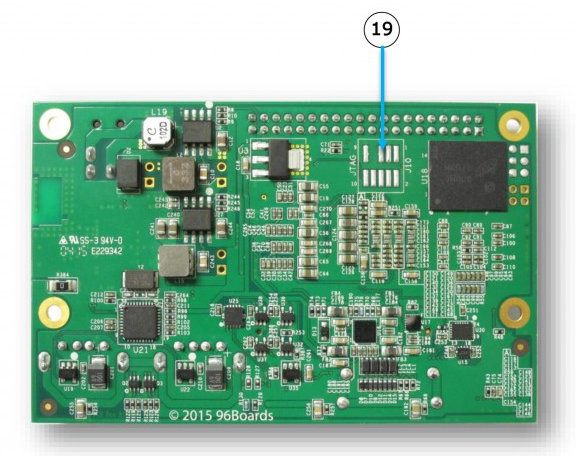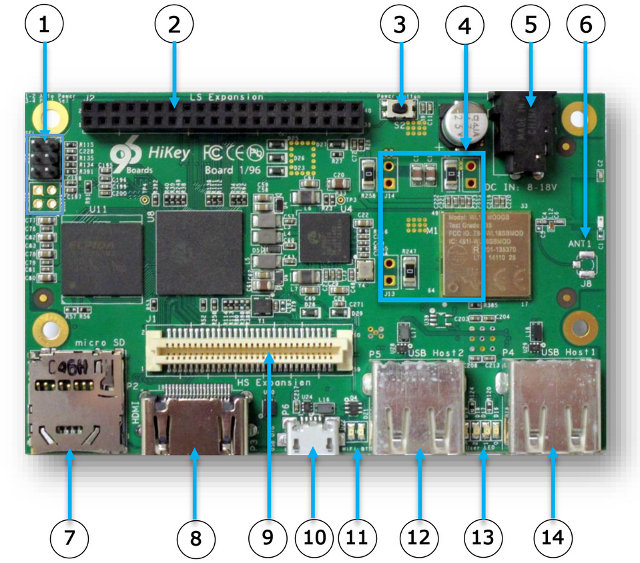In my post about the Embedded Linux Conference 2015, I noticed a talk entitled “Generalizing Android for Low-Cost 64-Bit ARM-Based Community Boards” to be presented by Khasim Syed Mohammed, Linaro, mentioning that “Linaro is developing an open hardware platform specification to encourage software development on low-cost boards to lower the cost and accelerate the availability of maker and embedded products based on ARM SoCs”. But at the time, I had no details about the specifications themselves. As Linaro Connect HK 2015 is now taking place, the 96Boards Consumer Edition specifications have been released, and Hikey board have been unveiled with HiSilicon Kirin 620 octa core Cortex A53 processor, 1 GB RAM, and 4GB eMMC.
Hikey board specifications:
- SoC – HiSilicon Kirin 620 octa core Cortex A53 processor @ 1.2 GHz (10,000 Dhrystone VAX MIPS) with ARM Mali-450MP4 GPU
- System Memory – 1GB LPDDR3 @ 800 MHz
- Storage – 4GB eMMC + micro SD v3 slot
- Video Output / Display – HDMI 1.3 up to 1080p, DSI interface
- Connectivity – 802.11 a/b/g/n Wi-Fi, Bluetooth 4.1 LE (TI Wilink 8 – WL1835MOD) with on-board antenna. Solder pads for external antenna are also present (6)
- USB – 2x USB 2.0 host ports, 1x micro USB OTG
- Camera – CSI interface
- Debugging – Unpopulated 4-pin UART header (1), unpopulated 10-pin JTAG header (19)
- Expansion headers
- 40-pin LS (Low Speed) Expansion connector (2) – 2x UART, 2x I2C, GPIOs, SPI, Audio, reset, 1.8V and GND, as wekk as 5V/12V cooling fan support
- HS (High Speed) Expansion connector (9) – DSI, CSI, SDIO, USB, etc…
- Misc – Power button (3), settings header for power/boot/user (1), power measurements through holes (Total / PMIC only / HDMI, USB) (4), LEDs for Wi-Fi/Bt (11), and 3x User LED (13)
- Power Supply (5) – 8-18V / 2A as per 96Boards specs.
- Dimensions – 85 x 54 mm
 Documentation is available on 96Boards.org, and currently includes a User’s Guide and schematics in PDF format. You can get support on 96Boards Forums, the source code is available on github, and binary images for Linux (Ubuntu?) and Android will soon be available at https://builds.96boards.org/.
Documentation is available on 96Boards.org, and currently includes a User’s Guide and schematics in PDF format. You can get support on 96Boards Forums, the source code is available on github, and binary images for Linux (Ubuntu?) and Android will soon be available at https://builds.96boards.org/.
Hikey board is available on backorder on Avnet and Arrow for $129 and up.
Let’s also have a quick look at 96Boards specifications.
Stated goals:
- Low cost ($50-$100 retail for a a minimum configuration)
- Easy to extend with off the shelf parts available to maker community and OEMs
- Easy to purchase globally (for example, via Amazon, Alibaba, Farnell, Digikey, Mouser, etc…)
- Enable a third party ecosystem to develop around expansion (mezzanine) boards/peripherals/displays, etc… that can be used on any 96Board CE compliant board.
Minimum hardware features:
- Ultra-small low-profile form factor – 85x54x12 mm – Extended Version: 85x100x12mm
- Design is SoC independent (targets 32- and 64-bit SoCs)
- 0.5GB RAM (Minimum 1GB recommended for Android_
- MicroSDHC Socket for up 64GB on-board or expansion flash storage
- Wi-Fi 802.11g/n and Bluetooth 4.0 LE
- On-board connectors and expansion I/O:
- 2x USB Type A or Type C host ports (USB 2.x or 3.x)
- USB micro-B USB or type C slave or OTG port (USB 2.x or USB 3.x) for PC connection
- Display and Audio Output: HDMI, or MHL (micro USB), or DisplayPort (USB type C)
- Low profile 40 way female header for maker/community use
- Low profile 60 way high speed female module header for advanced maker/OEM use with high speed interface including MIPI-DSI, USB, and optional MIPI CSI-2
- Board power from low profile DC jack connector
Other requirements and options include at least one current sense resistor, buttons, LEDs, UART, recommended JTAG, and so on.
Software requirements include bootloader (open source), accelerated graphics support (binary or open source), a Linux kernel buildable from source code based from mainline, or the latest Google-supported Android kernel version, or the last two LTS kernels, and one of more of the following operating systems: Android, Debian/Ubuntu, Fedora/Red Hat, or an OpenEmbedded/Yocto build of a Linux distribution.
[Update: Linaro blogged about this, with quotes by several companies including Actions Semiconductors and AMD, so we might expect 96Boards compliant board(s) by these two Silicon vendors too]
Via Mininodes.

Jean-Luc started CNX Software in 2010 as a part-time endeavor, before quitting his job as a software engineering manager, and starting to write daily news, and reviews full time later in 2011.
Support CNX Software! Donate via cryptocurrencies, become a Patron on Patreon, or purchase goods on Amazon or Aliexpress






A few more info with Google+: https://plus.google.com/104656570064624152708/posts/6gGbVPwCUBx
Hmm, as was intrigued by the use of CE, and as the picture shows the lame China Export symbol, you might have wanted to mention the CE in this context means “Consumer Edition”, nothing to do with electronic compliance. 😉
@anon
Yes, that’s a bit confusing since both “CE” and “CE” are different standards / specifications 🙂
@cnxsoft
I got confused with Actions Technology / Actions Semiconductors. The former is a subsidiary of the latter, and has just joined Linaro.
http://www.linaro.org/news/linaro-announces-actions-technology-founding-member-linaro-community-boards-group/
Their 96Boards CE compliant board will be based on Actions Semi S900 SoC with a quad-core ARM Cortex-A53 CPU and PowerVR G6230 GPU.
Marvell joins the party: http://www.linaro.org/news/linaro-announces-marvell-founding-member-linaro-community-boards-group/
Their 96Boards board will be powered by PXA1928 processor
@cnxsoft
Heh, I have confused those two Actions divisions too while researching who does the firmware for the chips. 😀
As a board spec, sure it should work just fine, need to see the Board 2/96 to see are they able to keep the spec the same for even two boards, there are way too many SoM standards, that are kept for exactly one board, and then changed every time there is a new chip used. 🙁
This is something big. It should have one or two SATA connectors somewhere though.
Btw, the SoC only supports one LPDDR3 channel, so an 32-bit DDR3 feeding eight Cortex-A53 cores… Outch!
Those cores are going to be sooooo much memory bandwidth starved, that even that low frequency of 1.2GHz is not going to help a lot, pretty much crippled the otherwise nice CPU grunt.
@anon
Based on the DMIPS/Mhz value on Wikipedia, a Cortex A53 core @ 1.2Ghz should be roughly equivalent to a Cortex A9 @ 1.1 GHz. There may be new Aarch64 instructions that could help with performance, but we should probably not expect a massive performance boost with Cortex A53 cores.
I think this platform is mostly interesting for developers who want a low cost platform to test their 64-bit applications, and learn more about the new architecture.
This is a very disappointing board. Only 1 GB of RAM. No SATA for mass storage, not even USB 3.0!
It will only be of interest for testing AArch64 software. You’re certainly not going to get very good performance out of this board.
@cnxsoft
Yeah, the A53 is the low-end core, an 64-bit version little version of the big.LITTLE for the A57/72, a’la A7 for the A15… But even 8 * A7 would starve an 32-bit memory port… I would go over dual core A7 or single A15 for such bandwidth, everything above that will be starved, especially if some freak would like to compile stuff on them. 😉
96Boards Enterprise will costs about $300,but include 2 to 16GB RAM, Gigabit Ethernet, eSATA, and more. Availability: Q2 2015. Source: http://www.slideshare.net/linaroorg/hkg15-george-grey-keynote
Not directly related, but you may be able to access ARMv8 server boards (Applied Micro / AMD Seattle) remotely, if you have a genuine use for it. http://www.linaro.org/leg/servercluster/
@cnxsoft
Have been set for APM Mustang boxes for a while now, but now another player coming in… Hmm, better wait for those to come out… :-S
@anon
Which other player (ThunderX?). Or is it a “I could tell you, but I would have to kill you” type of information?
@cnxsoft
Still TBC, but is a (brand) new player, and is already running native Gentoo, with only few adds (devicetree mods) to the daily git from kernel.org. 😉
Mininode is hosting two Hikey boards in their datacenter
https://www.mininodes.com/product/64-bit-arm-mininode/
Not directly related, but you can also access Applied Micro or AMD server boards hosted by Linaro.
Using Red hat and/or AMD server board requires you to sign an NDA.
AMD will launch one of the first 96Boards Enterprise Edition in H2 2015 with a quad core Opteron A1100 processor -> https://community.amd.com/community/amd-business/blog/2015/06/23/extending-arm-s-ecosystem-for-server-developers?sf38895017=1
2GB variant $99 (shipped I think):
http://www.seeedstudio.com/depot/HiKey-Board-p-2599.html